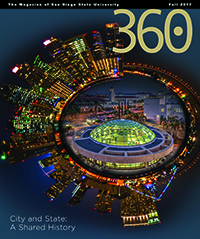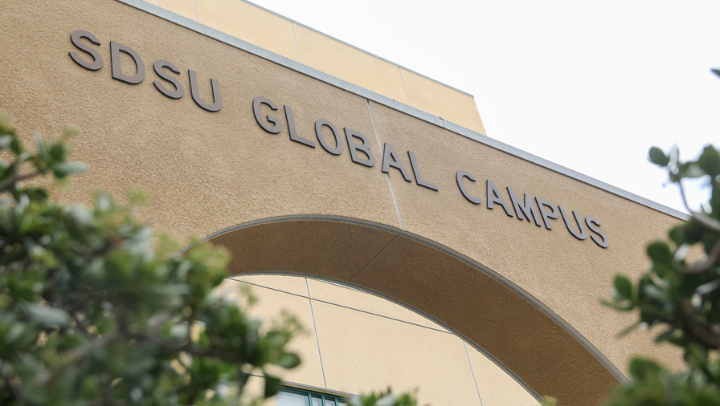Preserving Paradise
SDSU is the steward of one of Southern California's last wild places.

“This is a special place; you can just feel it.”
This story appears in the fall 2017 issue of 360: The Magazine of San Diego State University.
When Murray Schloss came to Riverside County in the 1920s to found a utopian society, little did he know his dream would come true—just not in the way he had planned. Rather than being a paradise on earth for believers in his utopia, the land he purchased has become a refuge for endangered wildlife and imperiled wilderness besieged by development on all sides. Today, the Santa Margarita Ecological Reserve (SMER) in southern Temecula is managed by San Diego State University as a critical wildlife corridor, a sacred ground for the region’s indigenous people and a field site for the SDSU students and researchers who study its fragile ecosystems.
SMER is one of two field stations managed by SDSU that offer students and professors opportunities to learn from their rugged wilderness. Molly Clemens, a doctoral student in ecology, is researching how differing carbon dioxide levels affect the viticulture of wine grapes growing in SMER.

“Fallbrook wineries will be producing and bottling the wine once grapes from our experimental vineyard are harvestable, and we can label and test these as ‘wines of the future,’” Clemens explained.
Biologist David Lipson and graduate student Sherlynette Castro recently completed a National Science Foundation–funded project to examine how different levels of rainfall affect the growth of invasive weeds.
“We found the combination of invasion by weeds and extreme drought causes the ecosystem to lose carbon and nitrogen, and this could represent a feedback with climate change and human disturbance that eventually degrades these ecosystem types,” Lipson said.
And last year, SDSU’s Natural History Club, advised by SDSU biologist and spider expert Marshal Hedin, conducted a “BioBlitz” at SMER, recording the numerous living species they encountered.
It’s also a boon to many other organizations in the community. Pablo Bryant, who graduated from SDSU with a biology degree in 1993 and has been reserve manager at SMER for the past six years, has helped set up more than 100 cameras throughout SMER and the county to detect smoke from wildfires both near and far. There are also dozens of signal stations in the reserve that offer wireless internet in this remote region, feeding into a larger National Science Foundation project to provide wifi connectivity throughout rural regions of San Diego, Riverside and Imperial counties. And earlier this year, a consortium of private companies partnered with SDSU to build a solar array on the land that will provide power to Temecula.
Before Schloss came to this land, it was a holy place to the Luiseño Native Americans who lived there. Features of the land figure prominently in their creation story, especially a site called temeku (from which the city of Temecula’s name derives), where the sun and the sand met to create the earth. Watching the morning sun filter through the sycamores and cottonwoods from inside Pablo Bryant’s rusty-yet-reliable old truck, it’s easy to imagine the world beginning here.
“This is a special place; you can just feel it,” Bryant said.
That tangible energy in the land is what drew Schloss to it. The scion of a Detroit-based garment magnate, Schloss had little interest in carrying on the family business. He was an idealist, his head perpetually in the clouds, and after graduating with a sociology degree from the University of Chicago, he took up leftist political activism in New York City. But his aspirations outstripped his abilities—his contemporaries described him as an “amateur socialist”—and after publishing series of failed left-leaning magazines and a doomed run for a congressional office in New Jersey, he quit politics.
A year later, Schloss’s father died, leaving his brother and sister the lion’s share of the family wealth and allotting Schloss only a fraction of those millions. Even that relatively small inheritance was to be placed in a trust, untouchable until he turned 50 years old. “His talents, which I have never failed to appreciate, do not run along commercial lines, and it is on that regard that I have made the best effort within my power … to relieve him from the burdens of my business matters, for which he is not as well fitted as my other children,” the father, Seligman Schloss, wrote in his will.
Murray Schloss threatened to contest the will and the family eventually settled out of court, bequeathing a large sum of cash to the young man. Schloss took his money west, moving to Los Angeles and falling in with a crowd of New Age thinkers. Southern California was a hotbed for theosophy and transcendentalism, and he fit right in. He began to write books on obscure topics, rejecting Euclidian geometry in favor of a system of mathematics more in tune with universal harmony.
Around this time, he also began hearing voices. They told him to found a new society built upon his nascent philosophy. In 1924, he purchased 2,500 acres from the state of California along the rugged and remote Santa Margarita River. He enlisted the few followers he had gathered to help him build his “Temple of the Dawn” in this land he poetically called “Heart-o’-the-Hills.” According to the group’s beliefs, human society was hurtling toward destruction and only his band of true believers would survive: the seeds of a new enlightened civilization.
It didn’t take. They were better philosophizers than engineers and his structures crumbled soon after they were built. Schloss never attracted more than a few dozen or so people to his cause and he died in 1927. Over the next few decades, his followers squabbled over Schloss’s remaining fortune. The courts eventually intervened in 1959 when the Riverside County Superior Court ruled the money should be placed in a trust to benefit the public good.
Stewards of the land
In 1962, Schloss’s property and remaining money were deeded over to San Diego State University, which was tasked with acting as steward for the land. This transfer arguably accomplished Schloss’s express goal “to promote or improve the all-sided progress of mankind” better than anything he did while alive.
Since then, SDSU has acquired surrounding land and today the ecological reserve sits at just under 5,000 acres of protected habitat. A working avocado plantation on the reserve offsets some of the costs of operating the reserve. But besides the avocadoes and a handful of residences scattered across the reserve—some abandoned, some seasonally occupied—it’s a wide open space, a breath of fresh air along the heavily congested coast.
Because the reserve has discouraged development, the 31-mile Santa Margarita River, which forms from the confluence of Temecula Creek and Murrieta Creek, enjoys the distinction of being the last free-flowing (meaning not dammed or diverted) river in Southern California.
It’s also a critical habitat linkage for many animals, especially mountain lions, which need to be able to breed with different populations to prevent genetic deterioration caused by inbreeding. SMER is the last strip of wilderness that connects the Palomar and Santa Ana mountain ranges, allowing mountain lions to maintain their genetic diversity.
Opportunities abound
Bryant and other SDSU officials work closely with The Nature Conservancy, the California State University system as well as other local universities, the Bureau of Land Management, the California Department of Fish and Game and Pechanga band of the Luiseño people to keep this land as rugged and remote as Schloss found it. That often means keeping out frequent trespassers, as well as fending off pressure from private citizens to open up SMER to the public. (As a protected reserve, public hiking within SMER is only available through docent-led hikes.)
“This has got to have a more noble purpose than just being a park,” said Bryant, who lives part-time within the reserve in a ranch house surrounded by avocado trees. “We have plenty of parks. We don’t have plenty of protected habitats for mountain lions.”
Despite all this activity, Bryant thinks there are even more unexplored opportunities for the SDSU community to learn from the land. “I think the reserve is an under-utilized resource,” said Bryant, who encourages students to do research projects at SMER. “Whether you’re studying environmental science, biology, agriculture, almost anything you can think of, there’s a good opportunity to do so here.”
If you would like to visit SMER, please arrange a docent-led guided hike by e-mailing smerdocenthikes@gmail.com.
Special thanks to Douglas McCulloh for detailing the history of Murray Schloss.



